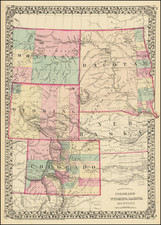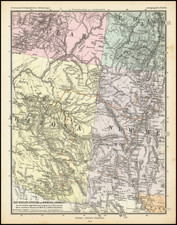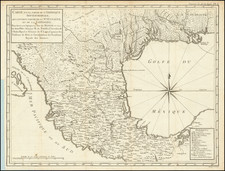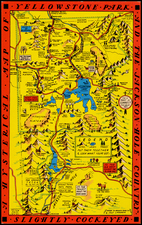An artifact of extreme historical importance - perhaps the only known contemporary map drawn by a Native American hand depicting a military battle.
This fascinating and highly important pictographic battle map was drawn by a member of the Comanche nation (perhaps the great Chief Ysampampi himself), and depicts one of only two documented battles fought between the Comanche (with the encouragement and support of the Territorial Governor of Spanish New Mexico) and the Faraones Apache Indians. The battle (the Battle of Sierra Blanca) was previously known only by the survival of two contemporary letters giving accounts of the event. This newly discovered map provides a remarkable first hand pictorial account of the battle, which was apparently given by Ysampampi to a Spanish agent, whom in turn delivered the map to Santa Fe.
The map is affixed to a larger sheet of paper which is dated July 30,1787 and is signed by Juan Bautista de Anza, the legendary explorer, who was then governor of Spanish New Mexico. The larger sheet provides an explanation of the pictorial battle, with key lettering interlineated onto the pictograph.
The map is also apparently the earliest surviving record of the battle, which was previously known only through two letters, one written by Anza to his Commander in Chief Jacobo Ugarte (October 20, 1787) and Ugarte's letter to Fernando de la Concha on January 23, 1788). It also greatly clarifies the timing of the encounter, as the modern accounts of this battle provide very different dating for the engagement.
The map also provides a unique contemporary Native American perspective on battle tactic, unvarnished by European influences.
Juan Bautista de Anza & Spanish-Native American Relations in the Lower Mountain West
Juan Bautista de Anza was born in Fronteras (near Arizpe), Sonora, Mexico in 1736. His father was the captain of the Presidio of Santa Rosa de Coro de Gauche, which lay on the northern frontier of New Spain. In 1737, his father famously proposed to lead an expedition to the lower Colorado River region, in search of rumored vast riches in silver. Unfortunately, in 1740, Anza Senior was killed in an Apache ambush before his mission received approval from the crown. Anza Junior was from a young age committed to fulfilling his father's dream to lead a great expedition to the west.
Anza Junior rose rapidly through the ranks, becoming the captain of the Presidio of Tubac. From there he was heavily involved in operations against the Apache nation. He was well-placed to gain intelligence on the nature of the lands to the west, and he employed this knowledge to formulate his proposal to lead the first overland expedition to Alta California.
In, 1772, the Spanish government agreed to sponsor Anza's first expedition to the missions of Alta California. During his first trek of 1774-75, Anza famously became the first European to open an overland route to California. Consequentially, this route would soon rescue the flagging California mission system, creating a lifeline of supplies and migrants. His second expedition of 1775-6 reached Northern California, where Anza selected the locations for future missions in the San Francisco Bay area. Anza's endeavors were universally considered to by a great triumph.
In 1777, Anza travelled to Mexico City, accompanied by the Yuma chief Salvador Palma. There he was feted by New Spain's Viceroy Antonio María de Bucareli y Ursúa and his Junta. As a reward, on August 24, 1777, the viceroy appointed Anza as the Governor of New Mexico.
The Spanish frontier province of New Mexico, anchored by its capital, the presidio of Santa Fe, had long been plagued by conflict with the region's native nations. During the mid-1780s, most worrisome were the almost constant raids by the fierce warriors of the Apache nation. Seeking to blunt the threat, the Spanish formed an alliance with their recent antagonists, elements of the Comanche nation, who were also ancient enemies of the Apache. This alliance was seen as critical, as Spanish reconnaissance teams had met with little success in tracking and engaging the bands of wily Apache warriors.
It was thus somewhat ironic that the early focus of Anza's administration was a campaign against the Comanche Nation. In the late 1770s, Comanche warriors had raised Spanish ire following their repeated raids on Taos. Anza conveniently allied himself with the Utes and Apache. In 1779, Anza led an army comprised of 800 Spanish soldiers accompanied by Ute and Apache warriors. Anza's force advanced north into what is now Central Colorado. At "El Capitan" (modern day Pikes Peak), he surprised a modest force of Comanche near what is now Colorado Springs. Anza's force pursued them southwards towards the site of modern-day Pueblo, Colorado. There they encountered a large Comanche force, led by Chief Cuerno Verde. In what became know as the Battle of Greenhorn Creek (named after the Comanche chief), Anza's force scored a decisive victory. This crippled Comanche operations in the region for years to come.
In 1783, Anza lead another successful punitive campaign against the Comanche on the eastern plains, after which the beleaguered Comanche sued for peace. Spanish-Comanche reconciliation was formally agreed at the Treaty of Pecos Pueblo of February 28, 1786.
Pecos Pueblo resulted in a dramatic realignment in Spanish-Native American relations in the Lower Mountain West. Hispanic traders in Sonora developed the 'Comanchero trade' with the Comanches, which showed itself to be far more lucrative than the trade with the Apache. The spurned Apaches soon turned on the Spaniards, causing Anza to militarily activate the Spanish-Comanche alliance.
It was in this context, that Anza provided the legendary Comanche chief Ysampampi with material support during his campaigns against the Apache in central and southern New Mexico. The aforementioned Battle of Sierra Blanca of July 1787, was one of the seminal events of the period.
Not long after Anza certified the present Comanche battle map, he resigned his post and returned to his native Sonora. Late in 1788, he was appointed to become commander of the Presidio of Tucson. Before he could take up his new post, Juan Bautista de Anza died in Arizpe, Sonora on December 19, 1788.
The Battle of Sierra Blanca & the Map in Focus
It was not long before Chief Ysampampi's Comanche war party enjoyed considerable success against the Apache. In April 1787, they ambushed and devastated a large party of Mescalero Apache near El Paso de Norte (El Paso, Texas).
A favored base for the Eastern Apache in staging their raids upon the Spanish settlements and ranchos around Santa Fe and the Rio Grande valley was the Sierra Blanca Mountains, located in south-central New Mexico (in modern Lincoln and Otero counties). The rugged stratovolcanic range, which rose to almost 12,000 feet in altitude, featured numerous fine watering holes and hiding places.
In the summer of 1787, Ysampampi turned his attention to removing the Apache presence from the Sierra Blanca. In late July, his party of warriors engaged a party of Faroanes Apache at an unknown location in the southern part of the range. Following the action on the present map, Ysampampi (noted by an A on the pictograph), led his 95 Comanche warriors (note B) into the engagement. The battle seemed to be a quick and sharply decisive engagement, in which 5 Apaches were killed (note C), 35 Apache prisoners were taken (note D), and 16 horses were captured (note E). In their resounding victory, the Comanche suffered only a single casualty (note F).
The battle in the Sierra Blanca was consequential as during the following months Ysampampi's party effectively removed the Apache presence form the mountains, forcing their retreat down the Rio Grande Valley.
The map was drafted immediately after the battle by a Comanche participant, perhaps Chief Ysampampi himself. It was duly submitted to Governor Anza as the official record of the altercation. Anza then ensured that the aspects of the battle that were pictographically portrayed on the map were related to a key with explanations in Spanish, which Anza certified, adding the date of July 30, 1787, and affixing his signature.
The present map is an artifact of extraordinary historical importance as one of the few contemporary maps produced by a Native American hand, and almost certainly the only 18th Century map to depict a specific and important event. The fact that it was considered and certified by such a legendary figure as Anza only adds to its significance.
The Explanation written below the map is as follows:
Explicacion de los precedents Caracteres.
A. Capn. Hissampampi, Com.[andan]te de la Expedicion. (Chief Ysampampi, Commander of the Expedition)
B. 95 Comanches concurrenter ala ant.[eri]or (95 Comanche towards the anterior).
C. 5 Apaches Muertos (5 dead Apaches).
D. 35 Pricioneros de los anteriores de todos Sexos. (35 prisoners of the former of both sexes).
E. 16 Cavallerias repressadas [sic.] (16 horses captured).
F. 1 Cumanche muerto de resultas de heridos (1 Comanche dead as a result of wounds).
G. 6 Cumanches enidos. (6 wounded Comanche)
H. 8 cavallos de Los anteriores tamvien eridos (8 horses [belonging to] the previous also wounded).
Villa de Sta. Fe, 30 de Julio de 1787. [signed] Anza.
Circumstantial evidence suggests that the present map remained in the possession of Juan Bautista de Anza, instead of being entered into the official archives of New Spain. The map was recently found as part of a collection that also contained original manuscript Anza material of an unrelated nature, an assemblage which most likely could only have been brought together by Anza himself. It was not uncommon for contemporary Spanish officials to retain maps received while on official business, as by unwritten custom, and unless otherwise specified, such items were considered to be the personal property of the official.
The Comanche "Tarjeta" of 1786: A Fascinating Comparison
A fascinating document sheds light on the present Comanche pictograph. In the Spring of 1786, shortly after the Treaty of Pecos Pueblo, Juan Bautista de Anza asked the Comanche chief Ecueracapa, to express, in graphic form, the number, nature and formation of the force he was intending to lead on an expedition against the Apache. To facilitate this process, Anza provided him with a blank version of a "Tally Sheet" (called a "Tarjeta" in Spanish) as a guide for giving the written report.
Shortly thereafter, a completed version of the "Tally Sheet" and oral report, was given to Anza by Oxamaguea, the son of Ecueracapa, and recorded in a "Noticia," written by Anza's secretary. This was the basis for a document entitled "Tarjeta remitió en blanco el gobernador Juan Bautista de Anza al capitán general comanche Ecueracapa el 19 de mayo de 1786…" (The Noticia and Tarjeta are today preserved at the Archive General de Indias (Seville) under the catalog reference: MP-Escritura y Cifra, 52).
"The Tarjeta" is a transcription of Ecueracapa's pictographic battle formation plan, made by scribes in Anza's employ. The "Tarjeta" is noticeably larger and of a far more refined style than the present Comanche pictograph, and the lines of symbols are more orderly and evenly spaced, commensurate with the work of an experienced Spanish draftsman. Notably, the "Tarjeta" is a Spanish copy of an original (supposedly now lost) Comanche document, whereas the present pictograph is an original document made by a Comanche hand.
That being said, there are some striking and truly significant similarities between the two documents. The "Tarjeta" and the Sierra Blanca pictograph both employ some of the same symbols to depict various elements the war parties. Horses are fittingly represented by the symbol of a horseshoe 'U'. Likewise, on both documents, Apache prisoners are shown with their 'heads down', while the use of 'downward arrows' represents warriors 'injured in battle.' Importantly, the "Tarjeta", which was made one year before the present pictograph, shows that the Comanche were using a series of standard symbols to depict. By these means the Comanche could graphically communicate important information with their Spanish allies.
The comparison of the two documents makes it quite likely that Anza and his aides may have immediately understood the content of the present pictograph pictograph when it reached their possession in July 1787, without necessarily requiring the details to be orally explained to them. On a broader level, these two documents, when taken together, show that the Comanche had a sophisticated understanding of graphic communication and their ability to communicate on paper had a profound impact on the nature of cross-cultural exchange between the Comanche and the Spanish.
The only published analysis of the "Tarjeta" is Alfred Barnaby Thomas's "An Eighteenth-Century Comanche Document," American Anthropologist, no.31 (April-June, 1929), pp.289-298. Importantly, apart from the present Sierra Blanca pictograph and the "Tarjeta", even after consulting with leading academic authorities, we are not aware of any other examples of such Plains Native American pictographs, or direct contemproary copies of such pictographs.
Archival References to the Battle of Sierra Blanca:
Jacobo Ugarte to Fernando de la Concha, No.2, Arizpe, January 23, 1788 and Juan Bautista de Anza to Jacobo Ugarte, no.1, Santa Fe, October 20, 1787, AGN PI 65, CSWR, UNM (Referring to the battle depicted).










![[ Upper California, Texas and Mexico ] Carte Generale Du Mexique Ed Des Provinces-unies De L'Amerique Central ou Guatemala](https://storage.googleapis.com/raremaps/img/small/81604.jpg)


![(Texas - Spanish Colonial Era) [Manuscript document of 1692 concerning Bahia del Espiritu Santo on the Texas Gulf Coast, signed by the Viceroy's secretary, Juan Francisco de Vargas Manuel de Lodeña]](https://storage.googleapis.com/raremaps/img/small/95766.jpg)
